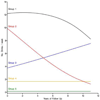Alcohol consumption trajectory patterns in adult women with HIV infection
- PMID: 22836592
- PMCID: PMC3534826
- DOI: 10.1007/s10461-012-0270-6
Alcohol consumption trajectory patterns in adult women with HIV infection
Abstract
HIV-infected women with excessive alcohol consumption are at risk for adverse health outcomes, but little is known about their long-term drinking trajectories. This analysis included longitudinal data, obtained from 1996 to 2006, from 2,791 women with HIV from the Women's Interagency HIV Study. Among these women, the proportion in each of five distinct drinking trajectories was: continued heavy drinking (3 %), reduction from heavy to non-heavy drinking (4 %), increase from non-heavy to heavy drinking (8 %), continued non-heavy drinking (36 %), and continued non-drinking (49 %). Depressive symptoms, other substance use (crack/cocaine, marijuana, and tobacco), co-infection with hepatitis C virus (HCV), and heavy drinking prior to enrollment were associated with trajectories involving future heavy drinking. In conclusion, many women with HIV change their drinking patterns over time. Clinicians and those providing alcohol-related interventions might target those with depression, current use of tobacco or illicit drugs, HCV infection, or a previous history of drinking problems.
Figures

References
-
- Galvan FH, Bing EG, Fleishman JA, London AS, Caetano R, Burnam MA, et al. The prevalence of alcohol consumption and heavy drinking among people with HIV in the United States: results from the HIV Cost and Services Utilization Study. J Stud Alcohol. 2002;63:179–186. - PubMed
-
- Theall KP, Clark RA, Powell A, Smith H, Kissinger P. Alcohol consumption, ART usage and high-risk sex among women infected with HIV. AIDS Behav. 2007;11:205–215. - PubMed
-
- NIAAA: National Institute of Alcohol Abuse and Alcoholism. Helping patients who drink too much: a clinician's guide. Rockville, MD: NIAAA Publications Distribution Center; 2005. [accessed July 7, 2012]. Available from: http://pubs.niaaa.nih.gov/publications/practitioner/cliniciansguide2005/....
-
- Braithwaite RS, McGinnis KA, Conigliaro J, Maisto SA, Crystal S, Day N, et al. A temporal and dose-response association between alcohol consumption and medication adherence among veterans in care. Alcohol Clin Exp Res. 2005;29:1190–1197. - PubMed
Publication types
MeSH terms
Grants and funding
- U01-AI-42590/AI/NIAID NIH HHS/United States
- P30 AI082151/AI/NIAID NIH HHS/United States
- U01 AI035004/AI/NIAID NIH HHS/United States
- R01 AA018934/AA/NIAAA NIH HHS/United States
- U01 AA020797/AA/NIAAA NIH HHS/United States
- U01-AI-34994/AI/NIAID NIH HHS/United States
- U01-AI-35004/AI/NIAID NIH HHS/United States
- U01-AI-31834/AI/NIAID NIH HHS/United States
- R01-AA018934/AA/NIAAA NIH HHS/United States
- U01 AI034994/AI/NIAID NIH HHS/United States
- P30 AI027763/AI/NIAID NIH HHS/United States
- U01-AI-34993/AI/NIAID NIH HHS/United States
- R01-AA-01759/AA/NIAAA NIH HHS/United States
- U01 AI034993/AI/NIAID NIH HHS/United States
- UL1-RR-024131/RR/NCRR NIH HHS/United States
- U01 AI031834/AI/NIAID NIH HHS/United States
- U01-AA-020797/AA/NIAAA NIH HHS/United States
- U01-HD-32632/HD/NICHD NIH HHS/United States
- U24 AA022002/AA/NIAAA NIH HHS/United States
- UL1 RR024131/RR/NCRR NIH HHS/United States
- U01 AI034989/AI/NIAID NIH HHS/United States
- U01-AI-34989/AI/NIAID NIH HHS/United States
- U01 HD032632/HD/NICHD NIH HHS/United States
- U01 AI042590/AI/NIAID NIH HHS/United States

